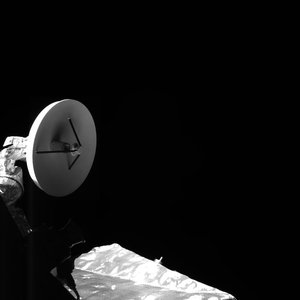

Turning BepiColombo’s high-gain antenna
Usually only the backside of BepiColombo’s high-gain antenna – which is attached to the Mercury Planetary Orbiter – is visible to one of the Mercury Transfer Module’s onboard monitoring cameras, but during a special set of movements to check the antenna’s pointing mechanism, rare views of the front side were captured.
In the last week of November, following a reconfiguration of the antenna pointing mechanism, a 2.8 degree pointing error of the antenna was noticed. After careful investigation, the anomaly was traced back to a setting in the antenna pointing mechanism electronics, which has subsequently been rectified. Investigating the issue required a range of special movements, which allowed one of the monitoring cameras to capture the first in-flight images of the front side of the antenna as its orientation changed.
Given the spacecraft’s current orbit and orientation, only the backside of this antenna is visible when it is pointing towards Earth. During the investigation, the medium gain antenna was used for communications with the Earth, but as of 30 November, communications moved back to the high-gain antenna again.
The images were captured by M-CAM 3 on 27, 28 and 29 November 2018, so the gif sequence shown here covers several days. The images show the main reflector dish, with the three struts holding the sub-reflector and the antenna feed at the centre of the main reflector dish clearly visible. The side of the Mercury Planetary Orbiter with the low-gain antenna, which protrudes from the side of the module, is also visible, together with some detail of the spacecraft’s multi-layered insulation. Two of the images combine two pictures with different exposure times to account for the different brightness levels of different parts of the spacecraft.
BepiColombo is a joint endeavour between ESA and the Japan Aerospace Exploration Agency, JAXA. It is the first European mission to Mercury, the smallest and least explored planet in the inner Solar System, and the first to send two spacecraft to make complementary measurements of the planet and its dynamic environment at the same time.





